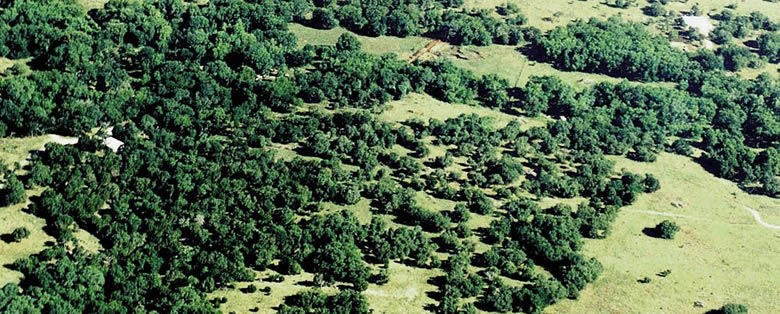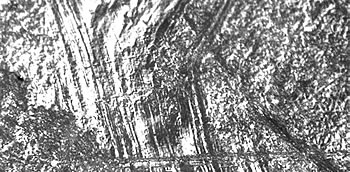
This spearpoint from the Gault site
is a classic Clovis point.
Click images to enlarge
|
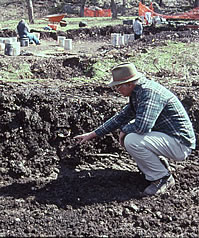
Mike Collins points out an artifact
at the Gault site. The disturbed area is a trench where
machines have been used to remove overburden—the
site's massive Archaic deposits were thoroughly churned
up by artifact collectors over a 60-year period.
|

His license plate says it all—Collins
lives and breathes Clovis.
|
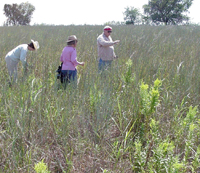
The Black Prairie was a grassland
for at least the last 15,000 years and still would be
today if the grazing, fire control, agriculture, and
concrete had not all but spelled its doom. Landowners
Bob and Micky Burleson (on right) have restored native
grasses on their property near the Gault site. Researcher
Marilyn Shoberg gathers Little Bluestem for experimental
work. Dense grasslands provided Clovis peoples with
a ready source of building materials—thatched huts
can be constructed in a matter of hours.
|
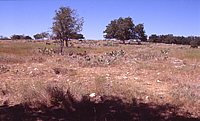
Looking out across the uplands from
the edge of the wooded valley at the Gault site.
|
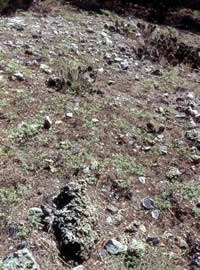
For over 13,000 years people have
been picking up flint at the Gault site. And yet, modern
flintknappers have hauled away pickup loads of it. Still,
you cannot walk 10 feet along the edge of the valley
without stepping on flint.
|
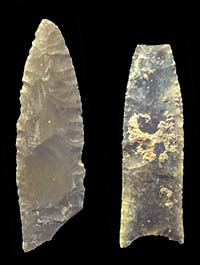
Clovis points from the Gault site.
(Click to see full image.) The yellow staining is caused
by iron-rich groundwater, while the white encrustation
is calcium carbonate, which is also carried by groundwater.
In some areas of the site, the lower Clovis deposits
are beneath the water table and can only be reached
during dry spells and with the aid of pumping.
|

Clovis blade cores. These distinctive
artifacts are blocks of chert (flint) that have been
carefully prepared ("set up" by chipping and
edge grinding) for the removal of prismatic blades.
This highly specialized technology allows a skilled
flintknapper to maximize the amount of useful cutting
edge that can be generated from a single chert cobble.
|

Clovis blades, a few of the hundreds
of specimens that have come from the Gault site. These
were used as is, as cutting tools, or were further modified
to create a variety of more-specialized implements.
|
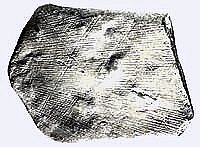
Incised stone. As you can see, these
are not random scratches, but carefully patterned, precise
lines almost certainly cut with sharp blades or flint
chips.
|
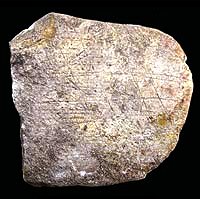
Incised stone.
|
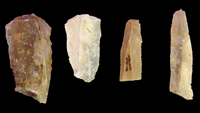
Clovis blades were used to make various
kinds of tools including hide or endscrapers (the two
specimens on left) and gravers with tiny beaks (two
on right). The small, delicate gravers hint at some
sort of specialized work.
|
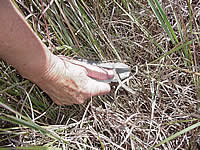
Researcher cuts Little Bluestem grass
with experimental blade.
|
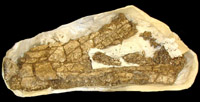
Scapula (shoulder blade) of an Ice-Age
horse from the lower Clovis deposits at Gault.
|
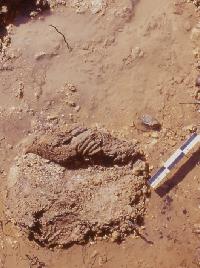
Mammoth mandible exposed in soggy
lower deposits at Gault. Because of the high water table,
archeologists can only excavate in some areas of the
site during prolonged dry periods or with the aid of
continuous pumping.
|
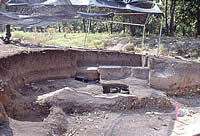
One of several large excavation areas
at Gault. The Clovis deposits are in the lighter sediment
below the dark band and continue into the upper gravels
visible at the right.
|

Clovis point and Clovis biface.
|
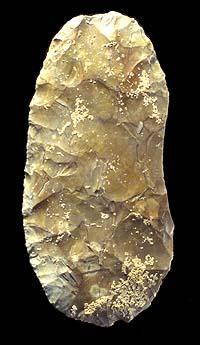
One of two Folsom ultra-thin bifaces
from Gault (click for full image). Some experts believe
that Folsom bifaces are so thin because they were designed
to be light enough to travel with. In contrast, Clovis
bifaces (points, too) are often much thicker and heavier.
|
|
For most students of archeology, "Clovis"
conjures up a vision of a distinctive spear point like the
one shown on the left and of small groups of "big game"
hunters killing Ice-Age elephants as they migrated across
North America. For over five decades the Clovis-first hypothesis—the
idea that Clovis hunters were the first people to explore
the New World—has been a fundamental part of the story
of the peopling of the Americas. Clovis peoples with their
remarkably sophisticated hunting technology were seen as the
first pioneers, highly mobile hunters who walked to North
America via the Bering Land Bridge. Once below the Ice Sheet,
small groups of Clovis hunters and their families expanded
rapidly across the continent killing mammoths so effectively
that the species was pushed over the brink of extinction.
Or so the standard story goes.
In the past decade, the Clovis-first hypothesis
has come under attack from many directions. There have been
multiple claims of earlier, pre-Clovis sites in North and
South America, none totally accepted, but several very credible.
And then there are the early skeletal remains found in North
America, such as the controversial Kennewick Man, whose features
are said to more closely resemble certain Caucasian populations
than later Native Americans. Adding to this, some stone tool
experts have made a case for a close resemblance between Clovis
technology and that of Late Paleolithic Europe. In the last
few years these claims, pro and con, have been reviewed in
Time, Newsweek, New Yorker, National
Geographic and on the Discovery Channel, among
others.
Meanwhile at the Gault site deep in the heart
of central Texas, Clovis culture is being reconsidered week
by week, midway through a planned five-year dig. The emerging
view hardly resembles the Clovis story known to generations
of archeology students. Instead of a new group of people exploring
an unknown land, we seem to see a people thoroughly familiar
with their surroundings. Instead of highly mobile elephant
hunters, we see what looks like a full-blown generalized hunting
and gathering culture living in the same kind of places and
doing many of the same kinds of things that characterized
Archaic-era life all across the continent a few thousand years
later. This is more than a new spin, this is a whole new way
of thinking about what is still, to many, America's earliest
recognizable culture.
The evidence presented here
is so new that most of it has yet to be reported, at least
not in a proper scientific sense. Research at Gault
site continues as does laboratory research and reporting. Several of the nation's leading Paleoindian
experts and specialists in various subfields and dozens of
their undergraduate and graduate students are working on different
aspects of the site. In other words, what follows is merely
a glimpse of what is to come, a peek behind the scenes and
into the head of Dr. Michael B. Collins, the lead researcher
who heads up the project. This is what he now (2001) thinks Clovis
life may have been like based on the emerging evidence. Like
any good scientist, he reserves the right to change his mind.
Collins fully expects the next few years will bring even more
surprises at Gault and elsewhere that will help paint a more
complete and accurate picture of the Clovis past.
Born and raised in Texas, Collins knew in high
school that he wanted to become an archeologist (see "A
High School Student Discovers Bone"). The Gault Project
brings together the three principal themes of his career:
lithics, early Paleoindians, and geoarcheology. His interest
in the early peoples of the New World started when he first
found Paleoindian artifacts around the playa lakes near Midland,
Texas, while still a teenager. He studied archeology and geology
at the University of Texas and then went on to get a Ph.D.
from the University of Arizona. As a stone tool expert he
is well known for his work with Tom Dillehay on the extremely
early Monte Verde site in Chile as well as a recent book,
Clovis Blade Technology (1999, UT Press). His interest
in geoarcheology, the marriage of archeology and geology,
developed as a natural outcome of his interest in Paleondian
cultures. Collins has worked on archeological projects in
many states, countries, and continents, none (with the possible
exception of Monte Verde) more exciting or important than
the Gault site. Being able to investigate a world-class archeological
site less than an hour's drive from either his Austin home
or his Williamson County farm is a dream come true for "Dr.
Clovis."
Ecotones and Endless Flint
To understand why Clovis peoples repeatedly
came to Gault and apparently stayed for quite some time, you
first have to know where it is and what it had to offer. The
Gault site is located in central Texas about 40 miles north
of Austin, halfway between Georgetown and Killeen (Ft. Hood).
It sits near the head of a small creek in a small wooded valley
just at the point where a number of springs come together
to form a clear, cool vigorous stream that has never gone
dry in historic times. This valley is one of many that cut
through the eastern flank of the vast limestone Edwards Plateau
that stretches far to the south and west. The Gault site is
in the northern part of the Texas Hill Country within the
Lampasas Cut Plain, where, as its name implies, the limestone
plateau is somewhat flatter and "cut" by many incised
stream valleys.
A three-hour walk down the creek valley, the
limestone country ends abruptly at the Balcones Escarpment
and the Black Prairie begins. This geological fault zone is
one of the most impressive ecotones in North America, places
where different environments come in contact. Moving east
along the creek, almost everything changes in just a few miles—geology,
hydrology, soils, plants, and animals.
The Black Prairie, so named for its rich black
"gumbo" clay soil, was a grassland for at least
the last 15,000 years and still would be today if the grazing,
fire control, agriculture, and concrete had not all but spelled
its doom. Spanish explorers in the early seventeenth century
rode their horses through grass so thick and deep in many
places that only the mounted riders could see where they were
going. They found plenty of buffalo and antelope to hunt on
the Black Prairie but when they turned west and entered the
rugged up and down world of the Texas Hill Country, they had
to rely on deer and turkey. They found dense, towering bands
of hardwood forest along the streams and an oak savannah in
the uplands with mixed grasses and trees, many of them stunted
and confined to mottes by periodic range fires.
Moving from the grand scale to the local, the
Gault site itself sits on a smaller scale ecotone that is
still obvious today even to the casual visitor. The road to
the site leads through the typical rocky limestone rolling
hills with very little soil and lots of cedar (juniper), live
oak, mesquite and prickly pear. As you approach the site,
the road drops off into the valley—only about 45 feet
lower, but what a difference. The deep, well-watered soils
provide habitat for huge hardwood trees—burr oaks, walnuts,
pecans, ash, elm, bois d' arc, and a dozen more species including
willow and cottonwood. In a word, it is lush. While we don't
have an accurate idea of what the local vegetation was like
in Clovis times, the contrast between valley bottom and the
surrounding uplands would have been just as stark.
So the Gault site was located on ecotones, large
and small, in a small, protected wooded valley with a spring-fed
stream. But it had one other important thing going for it—a
nearly inexhaustible supply of extremely high quality flint
(chert). The flint occurs as stream-worn cobbles along the
creek and it weathers out of the bedrock along the valley
slopes and in the uplands surrounding the site. For over 13,000
years people have been picking up flint here and yet modern
flintknappers have hauled away pickup loads of it. And still
you cannot walk 10 feet without seeing pieces of flint. Some
of the larger nodules are the size of a fat watermelon.
They Came To Stay
Most known Clovis sites fall into one of four
categories. By far the most numerous are places where isolated
finds of Clovis points are made. The next most common are
kill sites, places like Lehner and Murray Springs in southeastern
Arizona or Domebo in south-central Oklahoma where elephant
bones and Clovis artifacts were found together. And then there
are Clovis caches, isolated places were Clovis points, bifaces,
blades, or blade cores are found in tight piles thought to
represent hidden stashes. Finally, there is the rarest category,
camps—places where Clovis peoples stayed put long enough
for considerable debris to build up. Some camps occur in rockshelters
and others in open settings, but most known Clovis camps appear
to be the result of fairly brief stays. In contrast, the Gault
site is clearly a major base camp, a place where people returned
repeatedly and probably stayed for lengthy periods of time.
How do we know? Well for one thing it is a very
large site. Imagine a football field. Now add a second one
beside it. Now add two more pairs of fields end to end. And
this is only the core area of the site measuring about 80
by 300 yards where Clovis materials are known to be concentrated.
The entire Gault site covers an area about 90-100 yards wide
by about 650 yards long. Not all of this area has been tested
yet, but enough to get a fairly good idea of what lies beneath
the surface. The evidence is not spread uniformly; some areas
have much greater artifact densities than others. And it is
also clear that some of the deposits have been washed away
by floods—concentrations of Clovis artifacts have been
found within gravel deposits along the creek. It is not just
large, but incredibly rich. The Clovis deposits average about
40 centimeters (16 inches) thick but are sometimes twice that
or more, and in places the deposits contain unbelievably large
numbers of Clovis artifacts. Collins guesses that the Gault
site may have already yielded as much as 60% of all excavated
Clovis artifacts known today.
Base camps, as the name implies, are places
where people stayed for a while and ventured out from, repeatedly.
One characteristic they have is "assemblage diversity"—lots
of different kinds of artifacts. The diversity already recognized
at Gault is astonishing. There are many Clovis points—finished
points, worn out points, half-made points, resharpened points,
and lots of fragments. And Clovis bifaces—big heavy bifaces,
small thin bifaces, bifaces broken in manufacture, and several
kinds of specialized bifaces. There are also hundreds of Clovis blade
cores and blades—large ones, small
ones, crested outer blades, thin inner blades, broken blades,
and used blades. And then there are the blade tools—end scrapers
made on blades, serrated blades, blades with sharp graver-like
beaks, and blades with incredible use-wear traces. The finding
of several adzes or wood-working tools was quite unusual—this
tool form was not known previously from other Clovis sites,
although it occurs more commonly at later sites. Another interesting artifact from Gault is a bone or ivory rod, found in the ancient
gravel deposits of the creek amid definite Clovis artifacts.
It is very similar to specimens found in other Clovis sites.
Among the unprecedented finds at Gault are the incised stones—smallish,
smooth limestone rocks and chert (flint) flakes that have various patterns and designs
formed by shallow lines almost certainly made with sharp flint
flakes. More than 100 of these "mobile art" objects
are known from Gault, from early Paleoindian contexts as well as later Archaic-age deposits. The Clovis-age specimens may represent the earliest examples
of representational art in North America.
The artifact diversity obviously means that
many different tasks were carried out at the site and probably
elsewhere by work parties who returned to Gault. The Gault
researchers are not ready to enumerate these tasks in much
detail, but some patterns are already clear. First and perhaps
foremost, the Gault site was a major tool-making locality—a
lithic workshop where a great many stone tools were made,
most out of flint. All stages of tool-making were carried
out from the first stages of "primary reduction"
(breaking up large cobbles into usable pieces) to the final
stages of putting the finishing touches on a completed artifact.
And beyond—there are many resharpened and broken tools
at Gault that show people were "retooling"—taking
the time to replace broken and worn parts (such as the tips
of spears) with sharp new ones. While evidence is less direct,
a great deal of wood working, binding, and so on must have
taken place there as well. Tiny gravers—very small, delicate
stone tools with sharp beaks—hint at some sort of specialized
work—scarifying (scratching the skin to draw blood or
allow tattoo pigment to absorb) or incising bone, wood, or stone?
Although bone preservation is generally poor
in the Clovis deposits, there are enough bones of mammoth,
horse, and bison to suggest that these animals were killed
not too far away and at least partially butchered at the site.
Many tools speak to hunting and butchering—Clovis points,
bifaces and sharp blades with meat polish, and heavy choppers
probably used to dismember large animals. Endscrapers made
on blades suggest that hide working was another typical activity.
One of the most promising avenues for documenting
the daily activities of the Clovis peoples who stayed at Gault
is through use-wear analysis of stone tools. Using this approach,
Gault staff researcher Marilyn Shoberg has already identified
three very different tasks that Clovis blades were used for:
butchering, grass-cutting, and woodworking. She looks at individual stone
tools under 200x magnification using a binocular microscope
with polarized light and special eye pieces designed just
for this kind of work. At 200x, the edge of a Clovis blade
looks like an alien world complete with craters and mountains.
These micro-topographic features are the actual surface of
the stone tool.
When stone tools are used repeatedly, once-sharp
edges become dull and rounded and polish forms. Different
kinds of contact materials create different kinds of polish—high
polish, dull polish, domed polish and more. And when hard
particles, such as sand grains adhering to a hunk of mammoth,
come into contact with the polished edges, they leave striations—scratches
and gouges. The orientation of these blemishes tells Shoberg
which direction the tool was being pulled (or pushed).
The patterns seen on archeological specimens
must be compared to experimental tools used for known purposes
on known materials. These serve as control or reference samples.
Magnified surface of a serrated Clovis
blade. This 200x view shows well-developed polish and intersecting
striations thought to result from cutting up meat. Photo by
Marilyn Shoberg.
The picture above is the surface of a serrated
Clovis blade. The shiny polish is the kind that is associated
with cutting meat—butchering. Notice the criss-crossed
striations. The triangular pattern left by the intersection
of the striations is very characteristic of a tool used repeatedly
to cut the meat of a large animal. The different striation
directions imply that the blade was held in different ways
or at least at different angles.
Now compare this with the first picture on the
right showing the magnified edge of a Clovis blade with obvious
polish. Notice that most of the surface is completely smooth
and the edge heavily rounded. The polish is continuous, smooth,
and has numerous small pits and medium-sized comet-shaped
pits. This kind of polish is consistent with use in processing
plant material high in silicates, and is often referred to
as "sickle gloss." The edge (at the bottom of the
picture) is heavily rounded, which means that this tool was
used for quite some time.
Finally, compare the first two photos with the
second (lower) picture on the right showing the magnified
edge of an experimental blade used to cut Little Bluestem
grass, the kind that formerly covered much of the Black Prairie.
After 2000 strokes, characteristic silica polish is just forming
in a continuous band along the edge of the blade, and pockmarked
areas of polish extend back from the edge. The areas of polish
are not as large and continuous on the experimental blade
when compared to that on the archeological tool, suggesting
that the experimenters have many more thousand strokes to
put in. But the characteristic form of the polish on the replica
tool, with small pits and linear features parallel to the
edge of the blade, is very similar to that found on the archeological
tool. This comparison supports the hypothesis that the prehistoric
blade was used to harvest and/or process grass or reeds.
Shoberg has just begun to look at the Clovis
tools from Gault. She and other researchers will spend hundreds
of days staring under the microscope, taking notes
and photographs, and comparing archeological tools with more
experimental ones. Tedious work to be sure, but the result
will be a much more complete view of what Clovis peoples were
doing with their finely made stone tools.
How Long Did They Stay?
Among the things that are missing from the Gault
site are organic remains, especially charred plant remains.
The preservation conditions are such that so far not a single
charcoal fragment has been found from the lower Paleoindian layers (although many matrix samples
have been saved for further analysis). Charred plant remains
could reveal many important clues and they could be used for
radiocarbon dating. At present there are no radiocarbon assays
of Clovis age from the Gault site. Several
lines of evidence suggest that Clovis peoples visited the
site over a long period of time and may have stayed here for
prolonged periods.
Update: Since the exhibit was created in 2001, the Gault project has obtained a series of infrared stimulated (IRSL) dates from soil samples, a process that can determine when minerals in the soil were last exposed to the sun. The resulting dates nicely match the relative dates indicated by the distinctive artifact styles and give dates of around 13,000 years ago for the Clovis occupations at Gault.
The stratigraphy of the Gault site is very complex.
Because it lies within a narrow stream valley with deep deposits,
permanent springs, and multiple channels coming together,
the character of the deposits can change dramatically over
the space of a few meters (6-10 feet). It was a "dynamic"
environment, meaning that things could and did change quickly.
Major floods, for instance, changed the stream course repeatedly,
ripping up old deposits and creating new ones. As the continuing
excavations connect now-isolated excavation units and as various
geological and soils experts study the many samples that have
already been taken, entire books will probably be written
about the stratigraphy of the Gault site. But based on what
we know today, there are at least three distinct Clovis "components"
at Gault.
That is, in various places in the site there
are at least three distinct layers containing Clovis artifacts.
Their nature implies that these formed over extended periods
of time, decades at least and probably centuries. In the lowest
and hence earliest Clovis deposits, there are the bones of
mammoth, horse, and bison, all species that became extinct
at the end of the last Ice Age. In the later, upper two deposits
the only large bones that have been found are those of extinct
bison. Given this, it is possible that mammoth and horse became
extinct (at least locally) during the Clovis era at Gault.
It is obvious that a considerable period of time elapsed during
the Clovis occupations at Gault, several hundred years at
least and probably more. Based on the IRSL dates,
the Gault site could have been occupied as early as 12,000 B.C. and as late as 10,900 B.C.
Textbooks will tell you that Clovis points were
specifically designed for mammoth hunting. Yet, in the upper
(and latest) Clovis deposits at Gault it appears that no change
in weaponry was made after the extinction of the mammoths.
The Clovis points are still the classic form and they are
found with bison remains. Collins thinks this is another indication
that Clovis technology was a generalized rather than specialized
one. The prevailing concepts are ripe for reconsideration.
This still leaves the question of the nature
of the occupations: were these intermittent, as seems most
likely, or continuous? Researchers aren't sure yet and may
never be certain, but there are indications that the occupation(s)
may have been lengthy. The most obvious is the sheer quantity
of materials and size of the site—this must have taken
either lots of visits or a fair number of people over lengthy
spans of time.
Another clue is the amount of exotic lithic
materials. One of the most characteristic aspects of the stone
tools at most Clovis sites is that the discarded, worn-out-stone
tools are more often than not made of exotic non-local materials.
Many studies have shown that Clovis peoples routinely carried
or traded flint and other stones hundreds of miles from their
sources. But at Gault, exotic materials are very uncommon,
even among the worn-out tools such as Clovis points that were
broken and dulled and resharpened until they were too small
to be useful. Although no counts are yet available, the overwhelming
majority of all stone tools and tool-making materials at Gault
are made of the local flint. This strongly suggests that Gault
hunters commonly started and ended their trips at Gault and
that they did this throughout the history of the site.
Putting It All Together: Clovis Reconsidered
Based on the evidence just reviewed and on arguments
and data presented by many other researchers in recent years,
a new view of Clovis culture is taking hold. Clovis peoples
may not have been the pioneers who first settled North America.
Leaving aside the direct evidence for preClovis sites, there
is this: Clovis artifacts are known from all 48 of the lower
states plus southernmost Canada, Mexico, Costa Rica, Guatemala, and northern South America.
These continent-wide localities occupy a tremendous range
of environments, from coastlines to mountains and almost everything
between. The inescapable conclusion from these facts alone
is that most Clovis peoples were NOT highly mobile, specialized
mammoth hunters—they were generalized hunter-gatherers
who must have relied on animals of all sizes and a great many
plants. The emerging data from the Gault site lend very strong
support to this interpretation.
In addition to what has already been mentioned,
here are several more examples of the kinds of evidence from
Gault that reinforce this view. Among the bones found in the
Clovis deposits are turtle bones, burned frog bones, burned
bird bones, and small mammals yet to be identified. In Clovis
faunal assemblages across North America, the most commonly
identified animals are not elephants—they are turtles.
And the Clovis diet was not based on animals alone. This,
of course, is obvious anyway because humans can't live for
long on just meat. But at Gault, use-wear studies are already
finding evidence of a wide range of contact materials including
the stunning example of the Clovis blade with the highly developed
use-wear signature of grass cutting. While grass-cutting may
not have been for food (the tall grasses of the Black Prairie
are ideally suited for thatching and bedding), it is another
indication of the diversity of behaviors that are being documented
at the Gault site.
It should not seem surprising at all that Clovis
peoples were more than one-dimensional. They were, as we are
learning at Gault and elsewhere, much more interesting people
who adapted to a wide range of environments and climates and
behaved like generalized hunters and gatherers of the later
Archaic cultures of North America. Contrast this with Folsom
culture, the quintessential specialized big game hunters of
the Plains. All known Folsom sites occur within or near the
Great Plains and prairies of the midcontinent. And all of
the Folsom sites with animal bones have extinct bison bones.
No Folsom caches are known, suggesting perhaps that Folsom
peoples were so mobile and so focused on "encounter"
hunting strategies, that they did not plan ahead by caching
materials for the future. Folsom peoples did not make much
use of the prismatic blade technology, perhaps because blade
cores are heavy things that don't travel well. The ultra-thin
Folsom bifaces are light and the thinning flakes struck from
them well suited for making Folsom points and other artifacts.
Clovis is anything but Folsom-like.
For now, this is where we leave the story of
Gault and of Clovis reconsidered. Clovis culture will never
be seen again in the same light, as it has for so long. The
Clovis-first hypothesis—with all its implications of
specialized big-game hunters—is all but shattered. While
it hasn't been proved beyond doubt that preClovis peoples
existed in North America, Clovis peoples weren't anything
like those described by the long-held ideal. If they were
the first pioneers, as many archeologists still believe, they
were exceptionally adaptable and extremely fast learners (not
to mention prolific breeders) for whom killing mammoths was
just one of many successful strategies. The results of work
at the Gault site in central Texas will help lead researchers,
students, and the public to a much more sophisticated and
accurate understanding of Clovis culture.
|

Controversies over the peopling of
the Americas have made the cover of Newsweek and have
been featured in many other major media outlets.
|

Gault Project Director Dr. Michael
B. Collins enjoys a pun while introducing TAS volunteers
to Clovis lithics.
|
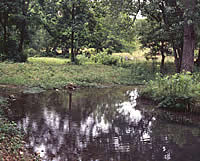
Gault sits near the head of a small
creek in a small wooded valley just at the point where
three spring-fed brooks come together to form a clear,
cool vigorous stream.
|
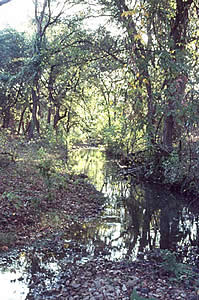
The spring-fed creek that winds through
the Gault site has never gone dry in historic times.
In fact, the water table is often so high that the lower
Clovis deposits cannot be reached without continuous
pumping.
|
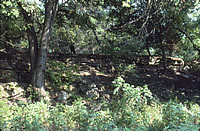
The deep, well-watered soils of the
stream valley provide habitat for huge hardwood trees—burr
oaks, walnuts, pecans, ash, elm, bois d' arc, and a
dozen more species including willow and cottonwood.
In a word, it is lush.
|

The vegetation in the rolling uplands
of the Lampasas Cut Plain is dominated by oak and juniper;
the latter has increased its density drastically since
the cessation of range fires.
|
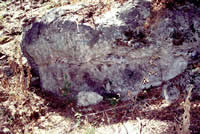
A seam of flint nodules is visible
in this limestone outcrop near the Gault site.
|
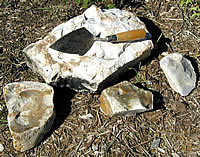
Nodules of flint from near the Gault
site. The flint at Gault is shiny and gray with distinctive
wispy gray inclusions. In many of the pictures, the
Clovis artifacts look yellow or orange—they are
iron-stained by prolonged contact with iron-rich groundwater.
|

Large Clovis biface, possibly intended
to be further worked into a spear point.
|
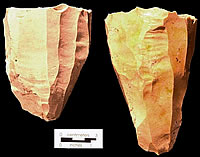
Clovis blade cores.
|
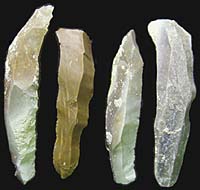
Clovis blades and tools made on blades.
|
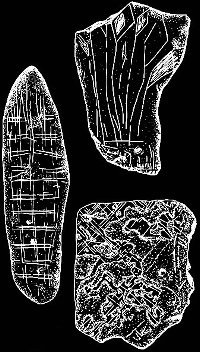
Incised stones. These may be the
earliest examples of representational art in North America.
Several dozen have now been found including several
that seem to depict animals. Drawn by Pam Headrick.
|
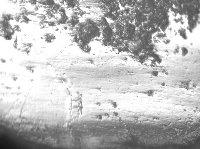
Magnified edge of Clovis Blade with
bright polish so well developed that it can be seen
with the naked eye. This 200x view shows extremely thick
polish and a heavily rounded edge thought to result
from the cutting of grass or similar plants. Photo by
Marilyn Shoberg.
|
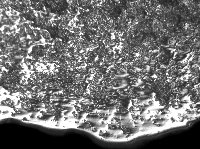
Magnified edge of an experimental
blade used for 2000 strokes to cut Little Bluestem grass.
Here the polish is just beginning to form a continuous
band along the edge and the edge is just starting to
round. Photo by Marilyn Shoberg.
|
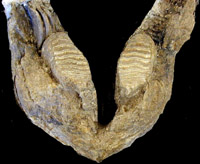
Mandible (lower jaw) from a young
adult mammoth found at the Gault site. This animal must
have been killed nearby.
|
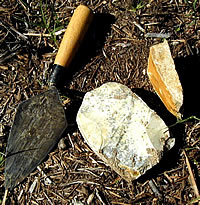
These heavy, wedge-shaped tools appear
to have been used as choppers or cleavers, perhaps to
dismember large animals.
|

Stratigraphic section at Gault. The
Clovis deposits are in the bottom third of this profile.
|

Clovis point fragment made out of
clear quartz crystal, a material that does not occur
locally. Several quartz crystal flakes found at the
site hint that this unusual material was brought to
the site in a raw or partially worked state.
|

Unfinished Folsom point broken during
manufacture at the Gault site. Only a small Folsom component
has been identified at Gault.
|
|
